


 |
May 28, 2017: The Bone Church at Kutná Hora; Interesting Sights in Prague |
 |
May 26, 2017: The Trip to Prague and an Afternoon with Jeffie |
 |
Return to the Index for Our Visit to Prague |
It's Saturday, and Jeffie will be spending the day with us, guiding us on a trip outside the city to see one of the Czech Republic's many old castles, and then returning with us to Prague to see some of the places in Prague that are a bit off the beaten path for the typical tourist. This is the value of having a local as your guide, rather than a tourist guidebook.
Before we start out on our day trip to Karltejn Castle, I want to say something about Prague's transit system.
|
Jeffie buys a monthly transit pass, which allows her to use any of these transportation systems, and go from one to the other. She had done some investigation, and found that seniors, like Fred and myself, can get discounted fares. In fact, seniors over 70 can ride for free on any of the systems! But seniors need some sort of ID, and Jeffie had found out about a transit card that we could get. On our way to Karlstein, we stopped at the main train station to inquire. We got instructions of how to get the cards- which involved using a photo booth to have our pictures taken. Counting the cost of that, the cards were about $4 for each of us. A picture of mine is at left.
Oddly, I found when I brought my photo back to the information booth in the station that we didn't actually need them; our passports would have sufficed. But the cards were convenient to have, and made a nice souvenir. Fred got 50% off on his daily passes, and I got to ride totally free! So in this respect, Prague does better for oldsters like myself than Berlin does; there, one only gets a discount.
A Day Trip to Karltejn Castle
Transferring to the Ibis Hotel in I. P. Pavlova
|
|
|
When Fred and I got to the Ibis about nine in the morning, we could not check into our room, of course, but I did complete the check-in process and we put our luggage in the bellman's storage room there in the lobby. Jeffie texted and said she was on her way, so we sat down in the lobby to wait for her.
The Trip to the Town of Karltejn
|
|
As seems to be the case throughout Europe, the train left almost precisely on time. From the main station, the train headed pretty much due south a mile or so and then turned west to cross the Vltava River just north of Vysehrad Castle.
|
|
|
|
The one-hour trip took us south along the west bank of the Vltava River, and then generally southwest towards Karltejn. A few miles south of Prague, and upriver on the Vltava, the Berounka River comes in from the west, and for the rest of our trip the train was never very far from that smaller river. This made some of the trackside views quite picturesque.
|
|
When the train slowed at our destination, we got our first view of Karltejn Castle, and we passed a little restaurant right before we came to a stop at the Karltejn train station.
The Town of Karltejn, Czech Republic
|
The other part of the town is the tourist area. Essentially, this part of Karltejn has shops, cafes, and other establishments that cater to the hordes of tourists that visit here. And this part of the town is situated so that the tourists can't avoid it; the shops and other establishments are arranged on either side of the one road that leads up the hill towards the castle. This part of Karltejn stretches for about a mile- all the way to the walkway up to the castle itself.
On the aerial view at right, you can see the Karltejn train station in the lower left; we walked from it along the road by the tracks, and then turned left on the road that crossed the bridge over the Barounka River. Other than that picture of the bridge, Fred took a picture of Jeffie alongside an interesting mural or drawing on a wall alongside the road. Not speaking Czech, I can't tell you what the legend says.
As we crossed the bridge over the Barounka River, Fred and I took quite a few pictures, and here are the two best, both looking downriver:
|
|
As you can see in the aerial view above, to get to the actual castle, one needs to walk up the single-lane road that is lined with all manner of establishments catering to the folks who need to walk up that road. I had the sense that this was the same idea utilized when you take a tour of something and at the end of the tour you find yourself having to exit through a gift shop; you are pretty much forced to peruse the stuff for sale on your way out. I likened this street to a mile-long gift shop that you have to navigate both to get into the castle and to get out of it.
|
|
About halfway up the road, there was a wide spot with a little plaza in the middle. It had a statue, the purpose and meaning of which I have not been able to discern, where we sat down to rest for just a bit. There are a couple of pictures of this statue above, right.
One neat thing about our walk up the street was that we were never out of sight of the castle itself looming above us at the top of the hill, and the castle appeared in almost all our pictures.
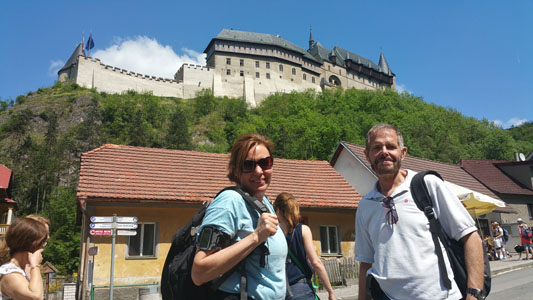 |
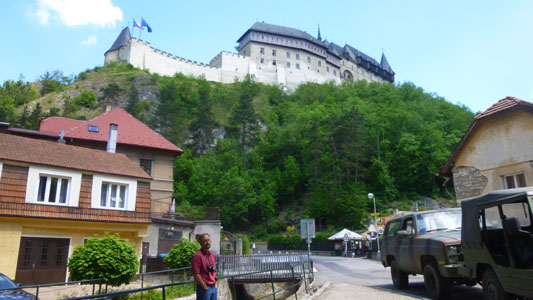 |
We did not know until we came to an informational sign near that statue that we were at the southern boundary of a protected landscape area called "Cesky kras". The area was established in 1972, and covers an area of about 50 square miles between Prague and the town of Beroun. The geological foundation of the area is palaeontologically-significant limestone karst. In the preserve are areas of dry rocky grassland, forest steppes and deciduous woodland habitats (such as where Karltejn is situated) with much native flora and fauna. There are many marked paths and nature trails through the preserve, some of which start/end at Karltejn Castle.
At right, below, is one of our best pictures of the castle looming above us, and at left is a slideshow of some of the pictures we took as we walked up the tourist street towards the castle. As with other slide shows, use the little arrows in the lower corners of the slide images to move from one to another.
|
|
After a 40-minute walk up the street, we found a ramp-like walkway off to the left that led up to the entrance to Karltejn Castle.
Karltejn Castle
|
Like many castles in Europe, Karltejn actually has two walls; the outer wall encloses the entire compound, while the inner wall encloses the main buildings of the castle- theoretically the area where the nobleman and his family actually lived. Here at Karltejn, one passes first through the gate in the outer wall. Here, the arched opening used to be secured by a pair of massive metal doors. When closed, these would become the first line of defense for the castle.
The view of the castle at left was not taken from the entry, but rather from the extreme southwest corner of the castle compound- right near the structure containing the castle's well; we'll look at that area in a bit.
Once you pass through that first gate, you are inside the outer walls, but still below the walled area that encloses the castle keep. To get inside the castle proper, there is a walk along a path that slopes upward for a couple hundred feet to a second gate.
|
|
At left is another view of this part of the castle structure. As you can see, comparing it to the picture at right, it was taken from about halfway up the path between the two gates.
We took a bunch of other pictures as we walked up the pathway to the castle keep, and there are three that I want to include here. You'll be able to figure out where we were when they were taken:
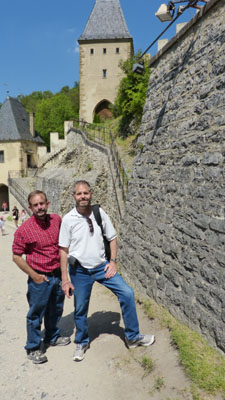 |
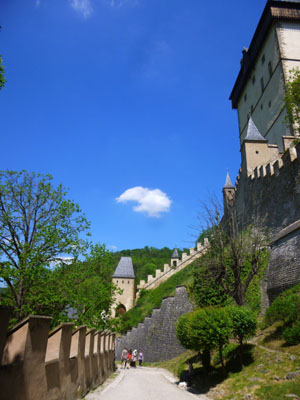 |
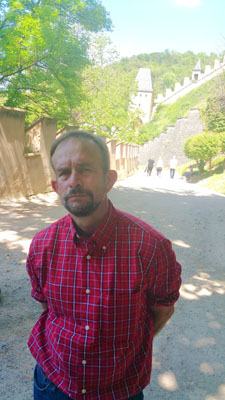 |
At the top of the path, we went through a second arched gate into the castle proper. We found ourselves in a large, open area, filled with people.
|
To the left of the lone tree, and stretching along the southeast side of the complex, was what appeared to be a relatively new building. It contained a shop or two and what appeared to be a ticket window. There were a lot of people at that window, and so we assumed that to get into the castle itself there would be a charge. That building extended around to our left, and eventually came to where what appeared to be the older part of the castle began.
|
We thought we should first scope out what was involved in getting into the castle itself, and so I wandered over near the ticket window to see if there were any signs posted that would give me that information. We found out that you could only get into the castle with a tour, that the tours were about $10 a person, and that the tours were filled up for the next couple of hours. So we decided that we would content ourselves with walking around all the areas of the castle outside; we only missed seeing the inside of some of the actual rooms.
|
Karltejn Castle was founded in 1348, and the construction works were directed by the later Karltejn burgrave (a burgrave had the rank of a Count, and was a hereditary title within a large noble family) Vitus of Bítov, but there are no records of the builder himself. Some historian speculate that Matthias of Arras may be credited with being the architect, but he had already died by 1352.
Historians deduce that the architect was not a progressive or particularly clever builder, but rather a brilliant civil engineer who dextrously and with a necessary mathematical accuracy solved technically exigent problems that issued from the emperor's ideas and requests. The Holy Roman Emperor Charles IV personally supervised the construction works and interior decoration. A little known fact is that the Emperor hired workers from the area around what is today Palestine for some of the construction work. Construction was finished nearly twenty years later in 1365 when the "heart" of the treasury the Chapel of the Holy Cross situated in the Great tower was consecrated.
Following the outbreak of the Hussite Wars, the Imperial Regalia were evacuated in 1421 and brought via Hungary to Nuremberg. In 1422, during the siege of the castle, Hussite attackers used biological warfare when Prince Sigismund Korybut used catapults to throw dead (but not plague-infected) bodies and 2000 carriage-loads of dung over the walls, apparently managing to spread infection among the defenders.
Later, the Bohemian crown jewels were moved to the castle and were kept there for almost two centuries, with some short breaks. The castle underwent several reconstructions: in late Gothic style after 1480, in Renaissance style in the last quarter of the 16th century. In 1487 the Big tower was damaged by fire and during the 16th century there were several adaptations. During the Thirty Years' War in 1619, the coronation jewels and the archive were brought to Prague, and in 1620 the castle was turned over to Ferdinand II, Holy Roman Emperor. After having been conquered in 1648 by Swedes, it fell in disrepair. Finally, a neo-Gothic reconstruction was carried out by Josef Mocker between 1887 and 1899, giving the castle its present look.
First, we went up the stairs to the viewing walkway, which gave us views along the north side of castle promontory that led to the well and observation tower overlooking the town of Karltejn.
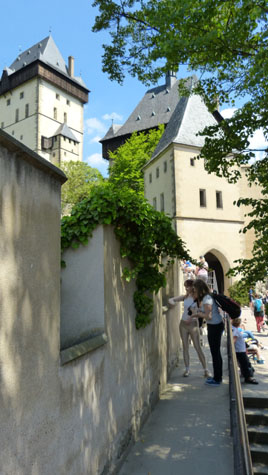 The Viewing Walkway |
(Picture at left) As you can see, the walkway was just a raised stone path that afforded castle occupants access to the points in the castle wall (right here, the outer wall and the inner wall were coincident, as the slope below the castle at this point did not afford attackers a feasible means of access). This view looks back towards the east towards the castle towers, including the Big Tower at left.
(Picture at right)
|
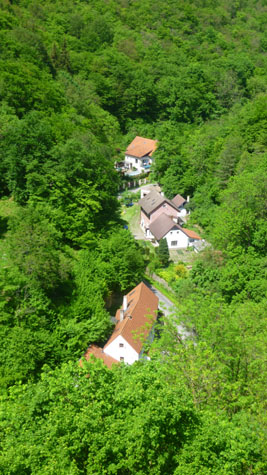 Below the Castle to the North |
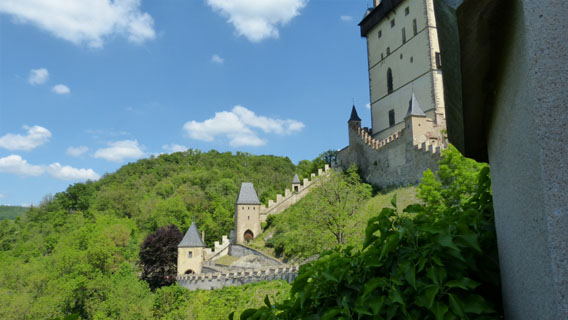 This view looks back northeast along the outer wall of the castle. You can see the Big Tower at right, the secondary castle entry down the wall to its left, and then below that the main gate that we actually came through to enter the castle (the pathway up being just on the other side of the notched wall). |
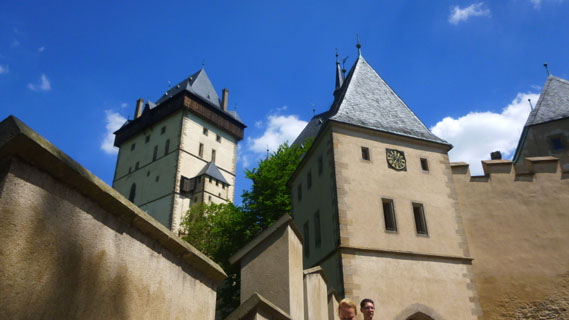 From the same point, this view looks back to the Big Tower and the main part of the castle- the tour area that was marked on the diagram above. |
From the west end of the walkway, we got good views of the area of the castle at the southwest point overlooking Karltejn. That was one of the areas that you could walk around without taking a tour.
|
These stairs brought us down to an open area below the plaza, and here we saw something interesting. First, we found that the stairs continued downward to another doorway through another castle wall and finally down to that promontory part of the castle. This small kind of courtyard area was mostly grass, but when we got down to the second doorway, we could look back and see some of how the castle was constructed. As you can see here, the outer wall of one of the castle buildings (the one in which the shops and other facilities were located) was built right on top of bedrock; that being the karst formation that underlies this whole area of Bohemia. We could only imagine that other of the castle and building walls were similar sitting right on top of this rock formation.
The doorway at the left of that last picture is the one that leads back up to the plaza level, and the second doorway leading down to the promontory area is just to my left. The castle was built upon a promontory from the south side of Knezi Hill, divided from it by a narrow sag. The first gate, a square, two-storey tower with a tall hip roof, stood above a moat at the western slope of the promontory. It was connected with the rampart traverse by means of a small portal. The traverse was protected by battlement and divided by a covered bastion in the middle. The second gate led to the Burgrave House (Purkrabství) courtyard. Drawbridges closed both entrances. The Burgrave House formed the Karltejn settlement, it was fortified with a two meters wide rampart, the Well Tower stood slightly lower. In the burgraviate's rampart a third gate was staved- the main entrance into the inner castle- the one leading to the stairway up to the plaza level.
|
|
Down in the area between the northern and southern castle walls there was a green area between the stairs leading down on the north side and the castle wall and observation walkway on the south side. This green area sloped down to end just at the southwest point of the castle, right at the entrance to the Well Tower. It was there that Fred and I sat down on a low wall and asked Jeffie to take a picture that looks back up the area towards the main part of the castle.
Here are three more views, all looking east and up towards the main part of Karltejn Castle, that I want to include in the photo album:
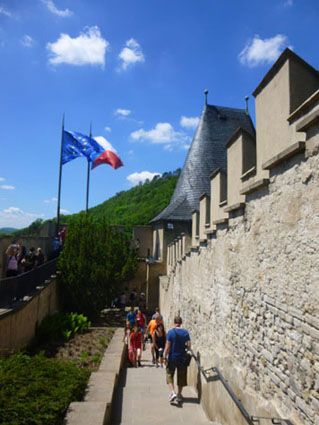 Stairs Down to Well Tower |
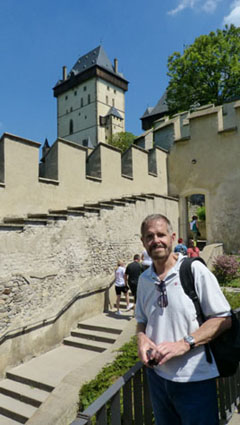 Looking Back to Castle |
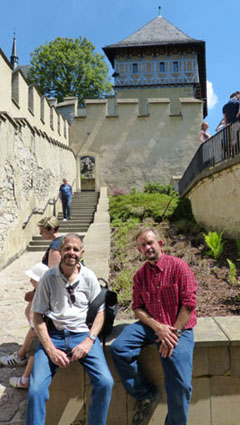 Fred and I in Promontory |
This area of the castle, the first area actually built, was very interesting, not for the least reason of which were the incredible views that one could get from the south wall of the area.
|
There were other good photo opportunities from the very end of the rampart; here you can see Fred with Karltejn Castle behind him. And below, fashioned out of three different pictures, is a panoramic view of Karltejn Castle:
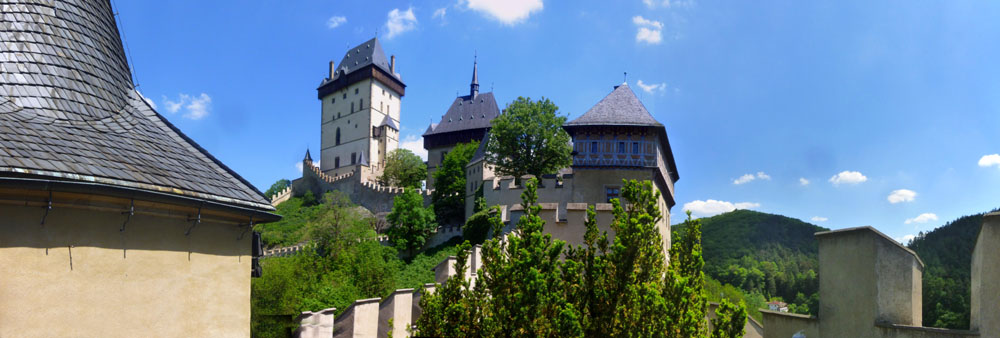
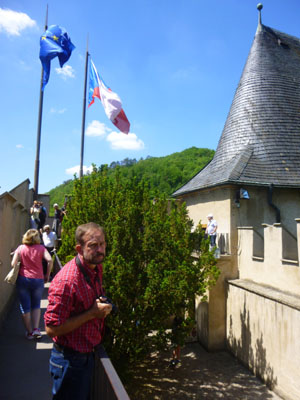 Looking West at Castle's End |
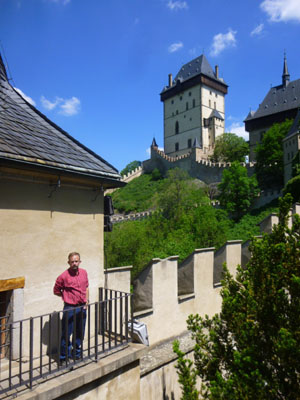 The Well Tower and North Wall |
The Well Tower, being the logistical centerpiece the castle could not function without, was the first part of the castle to be built.
|
Considering the significant strategic weakness incurred to the castle by the lack of an independent water source, the existence of the underground channel was a state secret known only to the Emperor himself, and the burgrave. The only other persons aware of its existence were the miners, who were however allegedly massacred on their way from the castle after the construction, leaving no survivors.
Visiting the Well Tower was our last stop here in the castle, considering that we'd decided not to take the tour. We retraced our path back up to the plaza and through the inner gate and back down the path to the outer one. Along the way, I got another nice view looking up at the Big Tower.
Outside the Castle Wall

I returned to join Fred and Jeffie and together we headed back down into Karltejn and our long-awaited gelato.
Other Castles in Bohemia
|
Our Return to Prague
|
|
We got back to the Ibis Hotel about two-thirty, and had some lunch with Jeffie. Before we headed out to see some sights in Prague north of the Vltava River, Fred happened to take a couple of pictures from our room of the buildings across the street. They are illustrative of the kind of structures in the newer parts of Prague, and the amount of decoration many of them have:
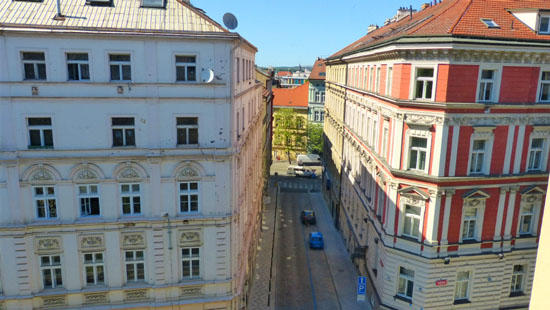 |
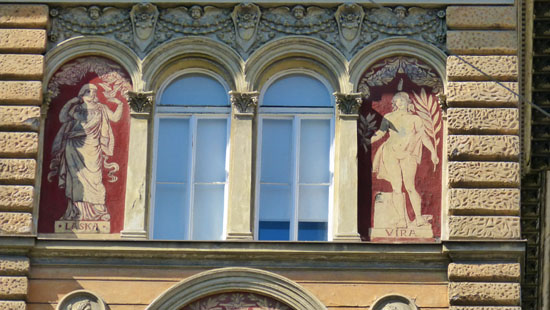 |
Troja Palace
|
|
One of the reasons that Jeffie had the Ibis on her list of recommended hotels was that it was so convenient to a major hub of the Prague transportation nexus, and we certainly found that to be the case during our visit. Incidentally, on the aerial view at right, where I have marked the Ibis Hotel, our room looked out the front of the hotel, and you can see the street and buildings that appear at the end of the section above in one of the pictures Fred took out our hotel window.
We descended to the I. P. Pavlova Metro station where we would hop on the Red Line and go about five stops to the north to Nadrazi Holesovice, the stop nearest Troja Palace. There, we'd transfer to an actual bus that heads west and stops right at the Prague Zoo, right across the street from Troja Palace and just a block down the street from the entrance to the Botanical Garden. As we were going through the station, Fred noticed on the wall what appeared to be some old building decoration repurposed as artwork. Fred also took a couple of good pictures down on the train platform:
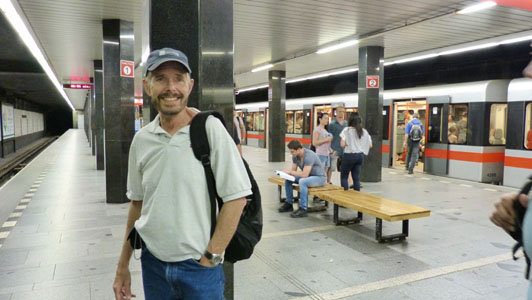 |
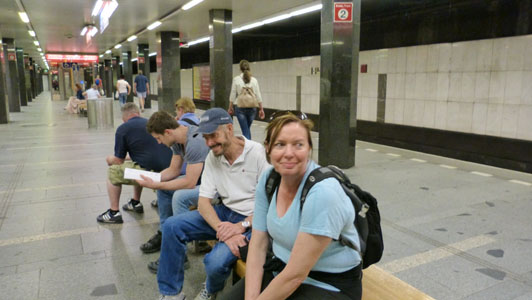 |
As usual, the transportation system worked flawlessly and quickly, and I think it was about twenty minutes after we actually left the hotel until we were alighting from the bus at the Prague Zoo stop- right across from Troja Palace. We crossed the street and entered the palace grounds.
|
At left is a 3D aerial view of the palace and its grounds (courtesy of Google Maps), and I have marked on it the approximate route we took walking through the property. It was getting late in the day, and even if we'd been of a mind to, going into the museum itself wouldn't have afforded us much time inside, and so we just walked around the stunning building and its even more beautiful gardens.
We stopped at the formal stairs in the wall north of the palace building, the garden maze to the east, a major fountain in the middle of the gardens to the south, and the formal, statuary-embellished stairs that led from the palace down into the gardens.
This was a palace, not a castle, so fortifications were not the issue; instead, the builders wanted the palace to be a showplace, and even though we didn't go inside, the outside certainly achieved its purpose.
|
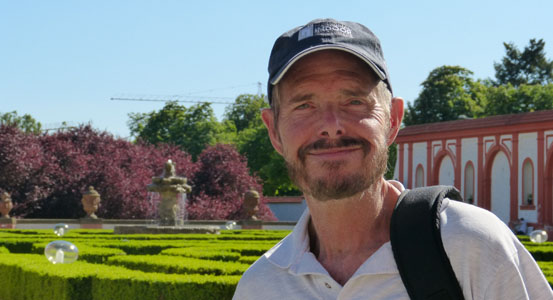
The palace's design was influenced by French and Italian architecture and was mostly the work of French architect Jean Baptiste Mathey. The latter also built the palais Buquoy in Prague, currently the French embassy. Another architect, Domenico Orsi, worked with him, and the palace was actually constructed by Master Builder Silvestro Carlone. As we came down the ramp-like entrance from the bus stop, I made a panorama of the palace area in front of us:

North of the actual palace building (at the left in the panoramic view above) was a formal wall- which presumably defined the boundary of the palace's property when it was built. It consists of a row of room-like storage areas, some open and some enclosed, and in the middle of the row a formal stairway leading up to what was either an entrance to the property or just a place where people could sit and admire the palace across the courtyard. Here is a panoramic view of this wall:

And here are Fred's two pictures of it- including the ornate stairway:
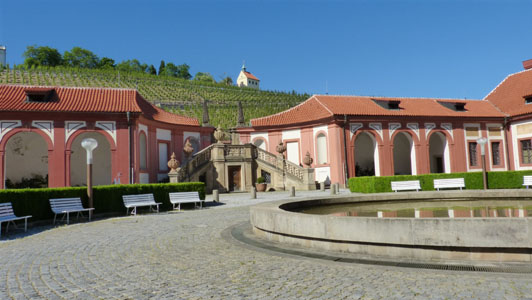 |
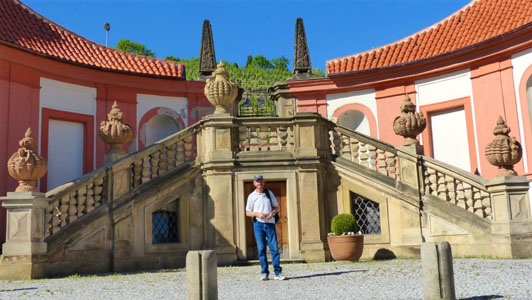 |
That seems to be a vineyard across the road on the side of the hill, and the small building near the top of the hill is, we discovered later, part of the Botanical Garden. I don't think we ever found out whether the vineyard was also part of the garden complex or something separate. Of course, turning around and looking south we could see the palace itself:
|
As we learned later from a brochure, the palace's main rooms are decorated with in a magnificent Baroque style favored by the Habsburgs. Many mythological elements are used in the inside decoration, and there are numerous trompe-l'il elements as well. The design is attributed to the brothers Abraham and Izaac Godijn, painters from Anvers who arrived at the castle in 1690. Other paintings in the castle were done by the artists Francesco Marchetti and his son Giovanni.
Outside, extensive use was made of sculptural elements- particularly on the garden wall stairway and the stairway on the south side of the house. Some archways had their own decoration, such as this whimsical equine sculpture in one of the archways in the garden wall.
|
|
 |
The rare vases along the terrace were made by Bombelli, an artist known for his ornate castle and palace decorations; he was the prime sculptor for the large Slavkov-Austerlitz castle close to Brno.
As you can see from the aerial view of the palace above, the gardens to the east consist of a circular garden "maze" that is at the center of a group of irregular, multi-sided geometric garden plots. Each of these consists of a seemingly unbroken hedge (the hedges were about head-high) around the boundary of the shape, with regularly-spaced small trees throughout the central portion of each shape. How gardners get inside the shapes to take care of the grass and trees would seem to be a mystery, but as it turns out, at many of the corners of these shapes there are narrow corridors through the hedges. At the bottom of the stairs, there was a walkway headed east towards the maze, so Fred and Jeffie walked ahead of me towards the maze. I thought I would make a movie as I, myself, walked after them, and I did. The player for my movie is below, left, and a picture Fred took of me as I began the movie is below, right.
|
|
Our reward for finding our way to the middle of the maze was the opportunity to photograph the large tree in the middle of the maze. We came out of the maze by a different route so we could go over by the fountain in the center of the gardens to the south of the palace building. On the way there, I stopped to get a picture of Fred with some sculptures that were sitting in a corner of the east garden. We walked to the fountain in the middle of the south garden, and I put together a panoramic view of it. We also took some pictures of each other with Troja Palace in the background, and if you click on the thumbnails below, right, you can have a look at them.
 |
|
Walking up to the palace from the fountain garden, we ascended the broad staircase that led from the palace level down to the gardens. At the top of these stairs, I looked back out towards the fountain to the south and put together a panoramic view:
 |
This brought us up to the twin curved staircases that led from the second floor of the palace down to the plaza level. The ornamentation on these stairs was the work of two sculptors from Dresden: Johann Georg and Paul Heermann. They sculpted statues representing the fight of gods and giants, and placed these on the balustrades of the stairs, on the landing at the second level, and even on a lower level below the plaza. These stairs were pretty amazing, and we took quite a few pictures and movies of them and the sculpted statues that adorned them.
|
 (Click Thumbnails to View) |
We spent quite a bit of time wandering up and down the stairs, and at one point I thought I would make a movie. You can use the player below, right, to watch it.
|

(Click on Thumbnails to View) |
We coutinued around back to the entrance to the grounds, and we came across another fountain in one of the square garden plots at the southwest corner of the palace and I stopped to have Fred pose with it. This brought us back to the entrance to the palace and grounds at their northwest corner near the bus stop, and I stopped here to take one last picture of Fred at the entrance to Troja Palace before we headed on to our next stop- Prague's Botanical Garden.
A Visit to the Prague Botanical Garden
|
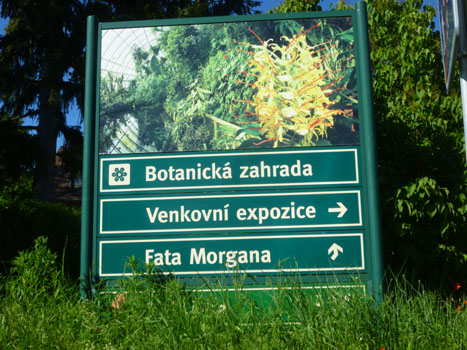 |
A ways past the column we found a street doubling back to our right, and a sign directing us down a narrow street to the entry to the Botanical Garden.
We found the entry with no problem, paid our entry fees (about $9 per person) and went into the gardens.
|
The Southern Gardens area had most of the traditional gardens areas, where plants were identified and described. In this part of the Botanical Garden, the first we wandered through, we found an interesting area that contained a number of evergreens that we had never seen before, various garden plots, and a bonsai garden with a little stream running through it.
It was also here that we found the historical Vineyard of St. Claire and the same-named chapel. Right by the chapel there was also an overlook that provided expansive views out across the Troja Palace that we had just left, the Vltava River just beyond, and, in the distance, the city of Prague. The views were pretty amazing, and I thought worth the price of admission all by themselves.
Fred, of course, was in his element; well, not exactly his element, as a great many of the plants and trees were varieties very much different than anything he'd seen before. Lots of things were familiar, but just a bit different, and that made the visit to the gardens an interesting experience.
As for all the pictures we took, I'll try to organize them a bit for you. Below will be sections for some of the major garden sections (like the evergreens and the bonsai garden), a section for the pictures we took at the vineyard overlook, the forest trails and the Fata Morgana, and a particularly interesting pool and sculpture that was one of the last stops we made. The rest of the pictures of individual plants and flowers I will put in a slideshow at the end of our Botanical Garden visit; you'll be able to see what Fred and I found interesting and worthy of being photographed.
The Evergreen Grove
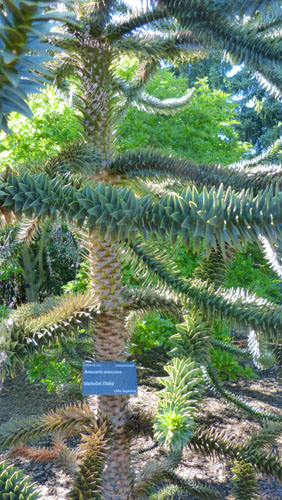 |
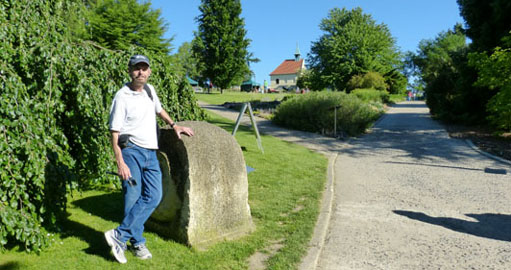
|
The Overlook at the Chapel of St. Claire
 |
Here are four more pictures of the view to the south, including the Petrín Lookout Tower in the distance, the Troja Palace and maze garden closer in, and the Vltava River south of that:
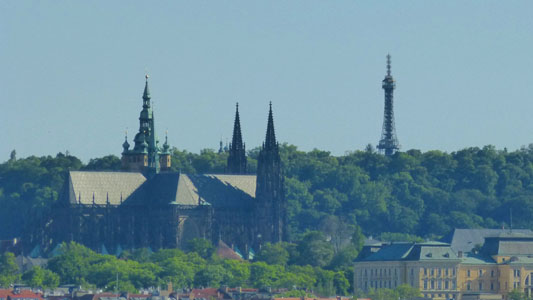 |
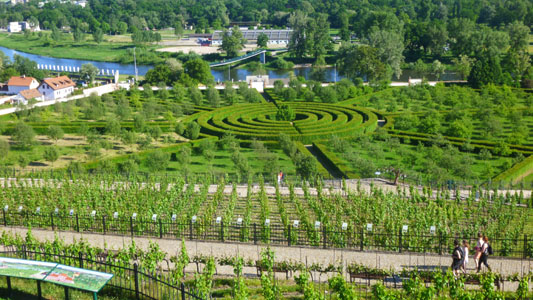 |
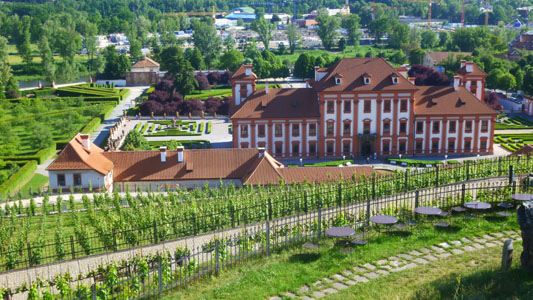 |
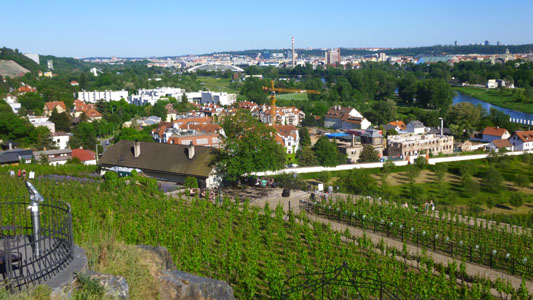 |
The Bonsai/Japanese Garden
|
|
|
|
The Northern Grounds and Forest Trails
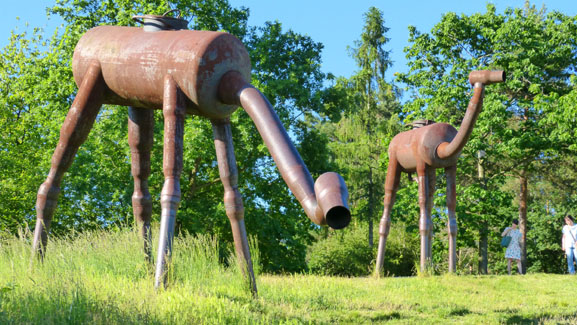 |
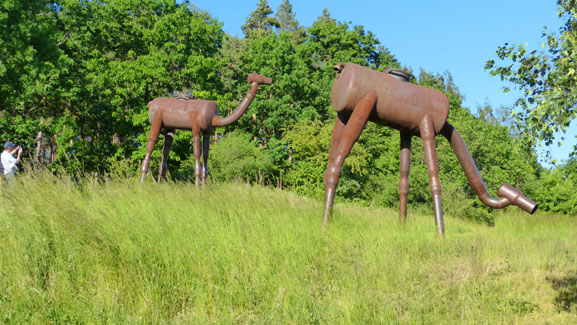 |
The statues of two strange animals "grazing" in Prague's Botanic Garden were a bit of a surprise. They are at the top of the hill with a nice vista of the city in the distance. The statues were made by the young Czech sculptor Lukas Rais (born 1975). He named the animals as "Lamy (On a Ona)" which means "Llamas (He and She)". The statues are made from metal scraps.
|
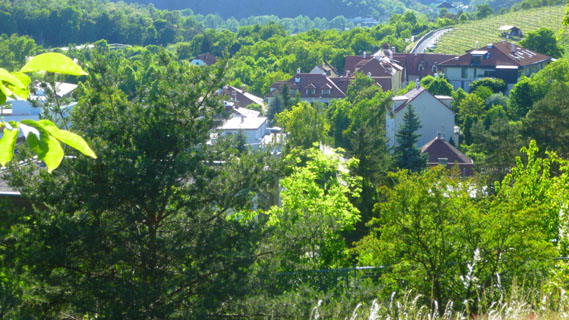 |
The views from here were very nice, and a different perspective than from the overlook near the Chapel of St. Claire. I stopped to take a series of three pictures, and I put them together into the panorama below. I would have let the camera do it, but when there is motion in the field of view (the two people walking along) you tend to get ghost images.
 |
We headed through the forest, filling our water bottles at a well just inside the canopy; there, as luck would have it, we ran across three young women visiting Prague from Houston. We got a bit lost in the forest, but eventually found our way to the trail along the northern border of the Botanical Garden; turning west, we followed the signs to Fata Morgana.
Fata Morgana: The Greenhouse
|
We spent some time reading about the greenhouse, since we couldn't go in. The first section consists of plants from arid regions of the tropics and subtropics- such as the Australian bush, Madagascar, South Mexico and some regions of Africa. Another section is a lowland rain forest of the humid tropics. There is a section of succulents as well as two large freshwater aquariums. Areas represented are South and Central America, parts of Australia and Oceania, Africa and Madagascar, Vietnam, and the Philippines. The chilled section is last- the harsh environment of the high mountains. Here one experiences the Andes, the alpine regions of both mainland and island Asia, subtropical South Africa, and the table mountains of Venezuela. We were very disappointed, particularly after reading about all the interesting areas inside. Perhaps on a return visit to Prague.
I took some time outside to put together a panoramic view of the greenhouse:
 |
We continued down the forest path, which had actually become something more like a dirt road. Further down the hill, we began to pass behind the residences that lie north of the Botanical Garden. Apparently, at least some of these residences use this road, which comes out on the street below the gardens, as their driveway. But before we got to that street, we found a gate leading back onto the grounds of the Botanical Gardens.
The Frog Pond
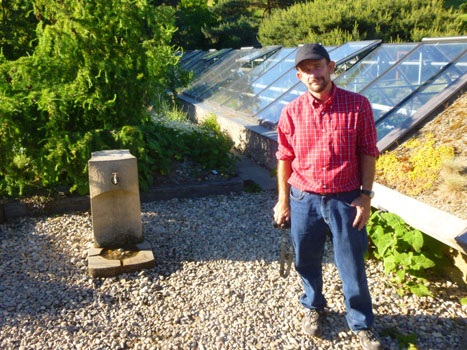 |
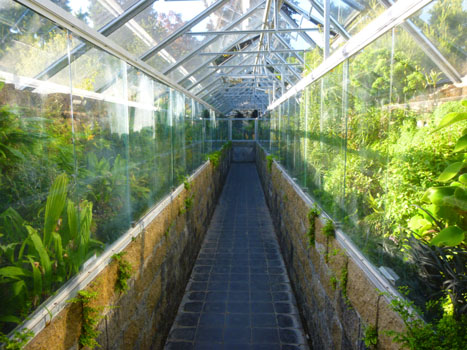 |
Near the greenhouse was the beginning of a short water feature- a little recirculating stream. It ran down towards the entry, ending in a small waterfall into a pond whose distinguishing feature was a huge leaping frog. Here are a couple of pictures of the pond and the frog:
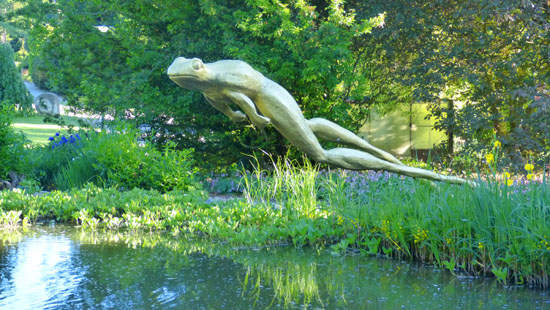 |
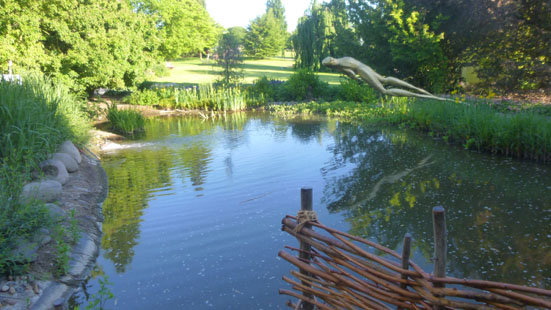 |
Another short walk and we were back to the entry point where we'd come into the gardens a couple of hours earlier.
The Slideshow
|
An Evening in Prague
Memorial to the Victims of Communism
|
It was unveiled in May 2002, twelve years after the fall of communism, and is the work of Czech sculptor Olbram Zoubek and architects Jan Kerel and Zdenek Holzel. It was supported by the local council and Confederation of Political Prisoners (KPV).
The memorial shows seven bronze figures descending a flight of stairs. The statues appear more "decayed" the further away they are from you- losing limbs and their bodies breaking open. It symbolises how political prisoners were affected by Communism.
There is also a bronze strip that runs along the centre of the memorial, showing estimated numbers of those impacted by communism:
|
The bronze plaque nearby reads:
| "The memorial to the victims of communism is dedicated to all victims not only those who were jailed or executed but also those whose lives were ruined by totalitarian despotism." |
Prior to the memorial being unveiled, there were reports in the local media about an apparent political row over who should attend the ceremony. President Václav Havel, a leading dissident in the communist era was not invited until the last minute, and then declined to attend. The memorial has not been universally welcomed, with some artists saying the memorial is kitsch and others critical that female figures were not included. One of the statues was damaged during two bomb blasts in 2003, no group has admitted carrying out the attacks.
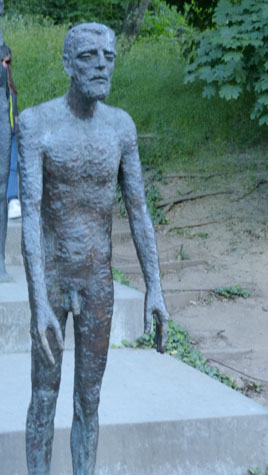 |
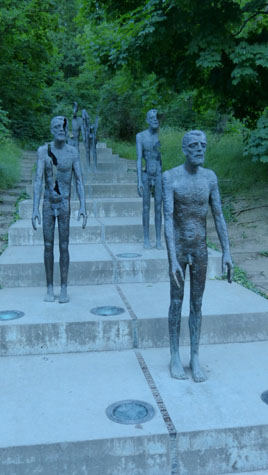 |
The chronicler Cosmas describes Petrín as a very rocky place; the hill is allegedly called Petrín because of the large number of rocks (Latin: petra). Since ancient times, stones were dug here and then used to construct buildings in Prague. A medieval defence wall, the Hunger Wall, was built on Petrín Hill during between 1360 and 1362, by the order of Czech King Charles IV. The Petrín Lookout Tower, which strongly resembles the Eiffel Tower, was built atop the hill in 1891. Other sights include the Rose Garden, Mirror Maze, St Lawrence Cathedral, the St Michael Church, and, of course, the Memorial to the Victims of Communism.
The summit of the hill is linked to Prague's Mala Strana district by the Petrín funicular, a funicular railway that first operated in 1891.
Dinner at Slavia Cafe
|
The cornerstone of the National Theatre was laid on 16 May 1868, but the idea of building a theatre had been in the works as far back as 1844. It took quite some time to get the project moving, but by the early 1860s there was enough support that a provisional building opened in 1862. A design competition was held, won by Josef Zítek, and in 1867 construction work began. The foundations were completed in November of 1868. In 1875, the new building reached its full height and in 1877 the theatre was roofed over. Another competition was held for the interior design, but since we didn't go into the building, I won't describe it here.
The ornamentation on the outside of the theatre includes a triga (a three-horse quadriga) and 10 exterior allegorical sculptures by Bohuslav Schnirch, 10 more exterior pieces by Antonín Wagner, the stone pieces by Max Verich and an interior sculpted pediment group over the proscenium arch by Schnirch. You can have a look at Fred's closeup of the sculptures; they are quite beautiful.
The National Theatre was opened for the first time on 11 June 1881, and 11 performances of the inaugural opera by Smetana were held before the theatre was closed down to enable the completion of the finishing touches. While this work was under way a fire broke out on 12 August 1881, which destroyed the copper dome, the auditorium and the stage of the theatre. This was seen as a national catastrophe, and within six weeks a million guldens were collected. This enabled not only the rebuilding but an expansion- under the direction of Zitek's pupil. The original design integrity was maintained.
The theatre reopened in 1883 and served with only minor modifications an technical upgrades for over 90 years. The theatre closed in 1977 for a major renovation. These were completed just before the theatre's 100th anniversary, and the reopening in 1983 featured a performance of the same Smetana opera.
|
|
After dinner, Jeffie had us walk with her a few block away to see what we thought was going to be your typical statue of a famous person- Franz Kafka, the Czech writer- created by David Cerny.
|
Below is Fred's movie and picture of the enormous bust of Kafka that is located about two blocks from the Slavia Cafe, directly above the Narodni Trida metro station. It was constructed in November, 2014, and weights around 35 tons.
|
Below is my movie of this marvel of modern technology driven by a motor and two-thirds of a mile of cables. The plates rotate independently of one another. The kinetic artwork undergoes various changes and metamorphosis; at times it is obvious that it is a face, at others it is not.
|
The sculpture is 35 feet tall, and is known as either Head of Franz Kafka or Statue of Kafka. It is comprised of 42 plates of stainless steel which turn and rotate, continually transforming the reflective sculpture. When all 42 of the moving panels align, the steel plates form the face of the famous Czech writer.
|
The mirrored sculpture is very similar to Cerny's statue entitled Metalmorphosis which is located in North Carolina. Cerny is also the artist who created the Giant Bronze Babies statues which are located in Prague's Kampa Park. You can find Cerny's work all over Prague. He is known for his controversial and unconventional art pieces.
Today was a busy day, and it was getting dark when we finally got back to the Ibis Hotel. Jeffie had been an excellent tour guide today, and we look forward to having her guide us around tomorrow as well.
You can use the links below to continue to another photo album page.
 |
May 28, 2017: The Bone Church at Kutná Hora; Interesting Sights in Prague |
 |
May 26, 2017: The Trip to Prague and an Afternoon with Jeffie |
 |
Return to the Index for Our Visit to Prague |